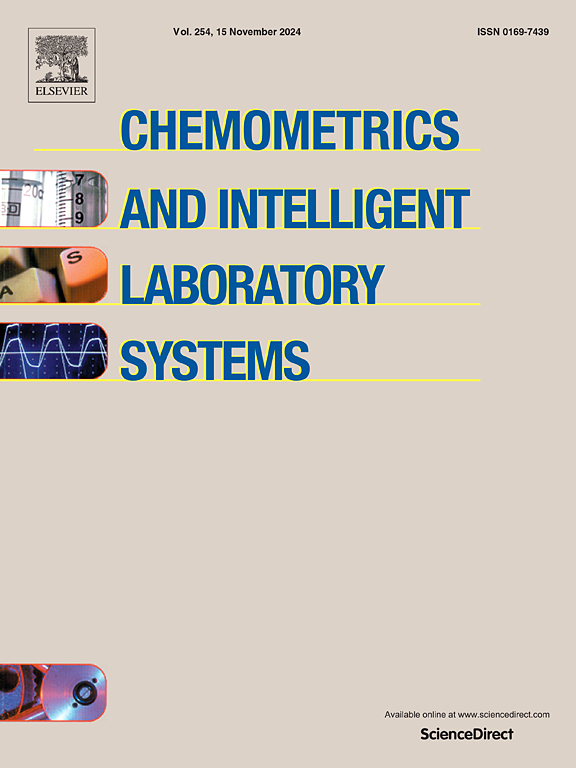开发一种新型智能化学计量辅助分子印迹电化学传感器:在提高帕金森病治疗效率中的应用
IF 3.7
2区 化学
Q2 AUTOMATION & CONTROL SYSTEMS
Chemometrics and Intelligent Laboratory Systems
Pub Date : 2025-02-15
DOI:10.1016/j.chemolab.2025.105351
引用次数: 0
摘要
在这项工作中,建立了一种新的化学计量学辅助电化学方法,该方法基于计算机化方法制备了一种新型电化学传感器,用于在靛蓝胭脂(IC)作为未校准干扰存在下同时测定左旋多巴(LD)、卡比多巴(CD)和苯拉西嗪(BA)。用多壁碳纳米管-1-丁基-3-甲基咪唑氯[bmim]Cl (MWCNTs-IL)修饰了玻璃碳电极(GCE),并在其表面电化学合成了三重模板分子印迹聚合物(TTMIPs)。分别采用Min Run筛选法和中心复合设计法对实验参数对传感器响应的影响进行筛选和优化。在优化条件下,记录三阶流体动力差分脉冲伏安数据,并通过MCR-ALS、PARAFAC2、U-PLS/RTL、N-PLS-RTL、U-PCA/RTL和APARAFAC进行建模,以选择最佳算法辅助传感器,在IC作为未校准干扰存在的情况下同时测定LD、CD和BA。我们的结果证实了MCR-ALS在辅助传感器分析合成样品方面表现出最好的性能。MCR-ALS辅助的TTMIPs/MWCNTs-IL/GCE也成功用于帕金森病治疗药物的分析,其性能可与作为参考方法的HPLC-UV相媲美。本文章由计算机程序翻译,如有差异,请以英文原文为准。
Developing a novel and intelligent chemometrics-assisted molecularly imprinted electrochemical sensor: Application to the improvement of the efficiency of the treatment of Parkinson's disease
In this work, a novel chemometrics-assisted electrochemical approach has been developed based on fabrication of a novel electrochemical sensor under computerized methods for simultaneous determination of levodopa (LD), carbidopa (CD) and benserazide (BA) in the presence of indigo carmine (IC) as uncalibrated interference. A glassy carbon electrode (GCE) was modified with multiwalled carbon nanotubes-1-butyl-3-methylimidazolium chloride, [bmim]Cl (MWCNTs-IL), and triple templates molecularly imprinted polymers (TTMIPs) were electrochemically synthesized onto its surface. The effects of experimental parameters on response of the sensor were screened and optimized by Min Run screening and central composite design, respectively. Under optimized conditions, the third-order hydrodynamic differential pulse voltammetric data were recorded and modeled by MCR-ALS, PARAFAC2, U-PLS/RTL, N-PLS-RTL, U-PCA/RTL, and APARAFAC to select the best algorithm for assisting the sensor with the aim of simultaneous determination of LD, CD and BA in the presence of IC as uncalibrated interference. Our results confirmed MCR-ALS showed the best performance to assist the sensor for the analysis of synthetic samples. The TTMIPs/MWCNTs-IL/GCE assisted by MCR-ALS was also successful in analysis of pharmaceuticals used as medications to the treatment of Parkinson's disease, and its performance was comparable with HPLC-UV as the refence method.
求助全文
通过发布文献求助,成功后即可免费获取论文全文。
去求助
来源期刊
CiteScore
7.50
自引率
7.70%
发文量
169
审稿时长
3.4 months
期刊介绍:
Chemometrics and Intelligent Laboratory Systems publishes original research papers, short communications, reviews, tutorials and Original Software Publications reporting on development of novel statistical, mathematical, or computer techniques in Chemistry and related disciplines.
Chemometrics is the chemical discipline that uses mathematical and statistical methods to design or select optimal procedures and experiments, and to provide maximum chemical information by analysing chemical data.
The journal deals with the following topics:
1) Development of new statistical, mathematical and chemometrical methods for Chemistry and related fields (Environmental Chemistry, Biochemistry, Toxicology, System Biology, -Omics, etc.)
2) Novel applications of chemometrics to all branches of Chemistry and related fields (typical domains of interest are: process data analysis, experimental design, data mining, signal processing, supervised modelling, decision making, robust statistics, mixture analysis, multivariate calibration etc.) Routine applications of established chemometrical techniques will not be considered.
3) Development of new software that provides novel tools or truly advances the use of chemometrical methods.
4) Well characterized data sets to test performance for the new methods and software.
The journal complies with International Committee of Medical Journal Editors'' Uniform requirements for manuscripts.

 求助内容:
求助内容: 应助结果提醒方式:
应助结果提醒方式:


